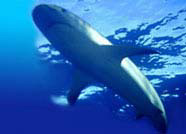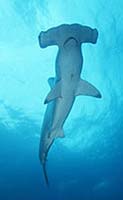


Great hammerhead

 |
 |
 |
|||
| Home | Evolution
| Classification
| Glossary | Biology
| Behavior | Shark
Repellent | Shark
Conservation | Do's &
Don'ts | Did You Know?
Great hammerhead |
 |
||||
|
Scientific Name: Sphyrna mokarran The great hammerhead is a fierce predator with a good sense of smell that helps it find its prey. The great hammerhead eats fish, including rays, and other sharks, squid, octopuses, and crustaceans. The great hammerhead is even known to be cannibalistic. Stingrays seem to be a particular favorite of the great hammerhead. It kills the ray by using its "hammer" to pin the stingray down while it takes bites from the ray's wings. The great hammerhead sharks are considered to be dangerous and many attacks on human beings have been documented. However, many of its species are considered docile and harmless. The great hammerhead swims in warm and relatively warm water along the coastlines. They live over the continental shelves and the adjacent drop-off (the upper part of the mesopelagic zone) to depths of about 260 feet (80 m). They also inhabit shallow reefs and are found at moderate depths offshore in all tropical waters. They can also be seen sometimes in water less than 1m deep. They are found in tropical and sub-tropical waters worldwide, but migrate seasonally towards cooler zones in summers.  Unlike their relatives the scalloped hammerheads, the great hammerheads are solitarysharks and prefer to live, hunt and chase alone. Like most of the sharks, Hammerheads too, are viviparous, giving birth
to totally developed live young, who then finds his way to life right
from the beginning. The females give birth to 20-40 pups, which are
about 70cm in length at birth.
|
|||||
| Sitemap | Reach To Us | Jimtrade - Business Directory of India | |||||